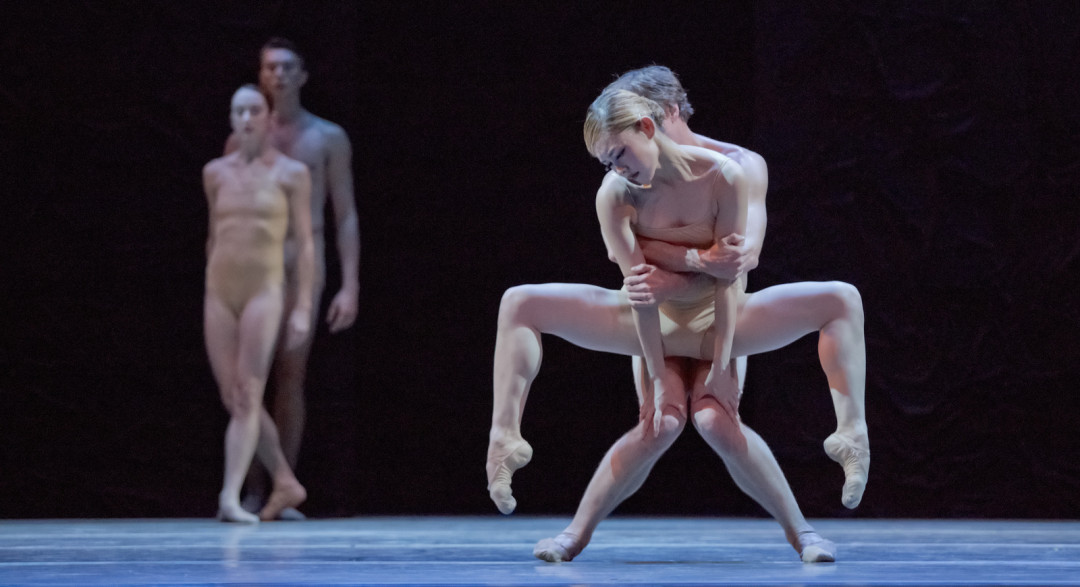Review: OBT’s ‘Dream’

Ansa Deguchi and Michael Linsmeier in Nacho Duato’s 'Por Vos Muero'
Image: Blaine Truitt Covert
In the opening night premiere, the company delivered a stunning performance of Duato’s Por Vos Muero (which translates to “For Thee I Die”). OBT’s new artistic director, Kevin Irving, was in the studio with the choreographer when he created the work in 1996 and has used his first-hand experience to lead his dancers in a piece that serves as a refreshing deviation from the company’s norm. Duato’s inspiration for this piece stems from 15th and 16th century Spanish music as well as the love poems of Garcilaso de la Vega, which, at times, are hauntingly read over the performance in their original Spanish. Fusing Renaissance court and country dances with classical ballet and a modern influence, the choreography is sensual and hypnotizing, rapidly alternating in mood from dark and ominous to light and festive.
Por Vos Muero has a particularly magic to it; one that captivates and mystifies at once. The curtains open to a full ensemble of dancers dressed in flesh-colored costume under dim lighting, moving in slow motion before peeling off one-by-one into fierce yet pedestrian movement. They disappear behind staggered curtains at the back of the stage—a production choice used to its fullest to amplify the mystery—emerging again in minimalist Renaissance garb, most often in pairs, although occasionally as the full ensemble.
Many of the pas de deux’s portray love and longing, dripping with chemistry and emotion. Others capture more playful emotions, particularly a trio of jesters. But the two standout moments are ensemble works. The first occurs when the male dancers emerge in shimmering capes spinning incense censers from chains like arcane medieval priests. Chilling music melts fluidly with rippling fabrics and billowing smoke, creating gauzy haze that barely separates the audience from the dreamlike spectacle before them. The second moment comes with the entrance of the female dancers wearing plain, white masquerade masks that they remove and dance with to an unearthly and haunting effect.
Up to the task, OBT’s dancers (particularly Ansa Deguchi and Makino Hayashi) execute Duato’s chorography with gorgeous carriage, relentlessly fluid movement, and lines and limbs that go on forever. The disappointment only sets in with the realization that the performance does not.
Oregon Ballet Theatre: Dream
Keller Auditorium
Oct 17–19 at 7:30
The second half of the show takes a lighter approach to the theme of the evening. OBT’s previous artistic director, Christopher Stowell, puts an original spin on A Midsummer Night’s Dream, working backwards from the final wedding scene and staging a forest set that mimics Oregon’s own Opal Creek. The work is whimsical and playful, with fairies and children dressed as cartoonlike bugs and butterflies. Female dancers are incredibly elegant and poised in their technique, while the male dancers strike a balance between athleticism and grace, pirouetting with unnerving control.
The audience laughs as the star-crossed lovers make fools of themselves, but when compared to the first act, it feels too long and in need of some modernization to give it spark. Then just as my attention is drifting, the closing scene takes my breath away, pulling the audience back to its dream-state. The curtain closes on the fairy queen (Alison Roper) spinning ceaselessly in arabesque, just as I would close the lid to my childhood jewelry box and know the porcelain ballerina inside would still be twirling away when I opened it next.




